oil Oldsmobile Cutlass Supreme 1995 s User Guide
[x] Cancel search | Manufacturer: OLDSMOBILE, Model Year: 1995, Model line: Cutlass Supreme, Model: Oldsmobile Cutlass Supreme 1995Pages: 340, PDF Size: 16.68 MB
Page 215 of 340
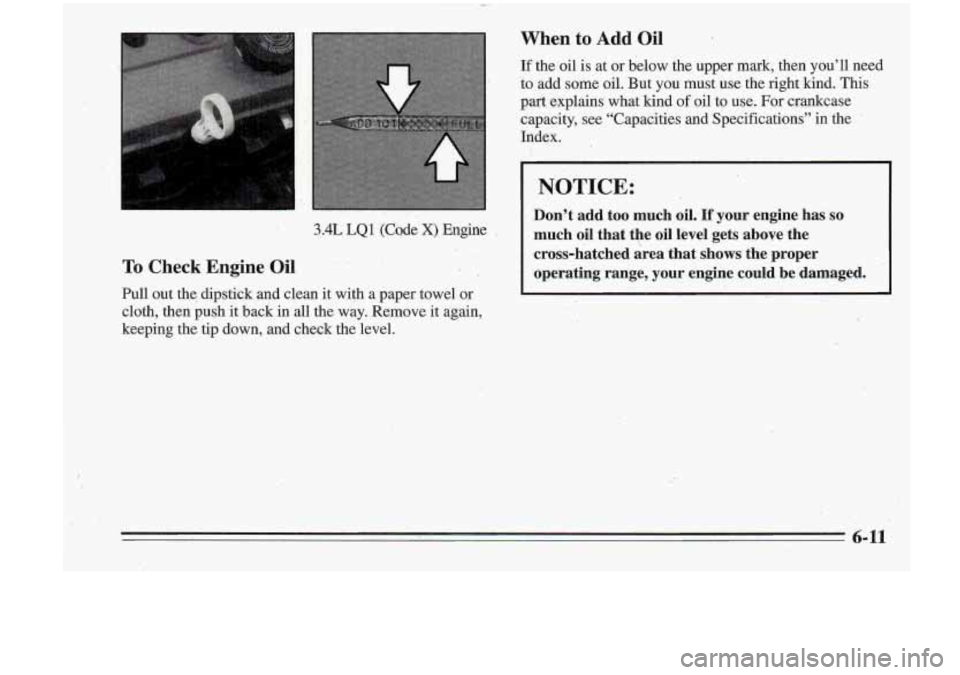
3 .k
..
4L LQ1 (code X) Engine
To Check Engine Oil
Pull out the dipstick and clean it with a paper towel -or
cloth, then push it back in all the way. Remove
it again,
keeping the tip down, and check the level.
When to Add Oil ,
If the oil is at or below the upper mark, then you’ll need
to add some oil. But you must use the right kind. This
part explains’ what
kind of oil to use. For crankcase
capacity, see “Capacities and Specifications” in the
’
Index.
NOTICE:
Don’t add too much oil. If your engine has so
much oil that the oil level gets above the
cross-hatched area that shows the proper
operating range, your engine could be damaged.
6-11
~
Page 216 of 340
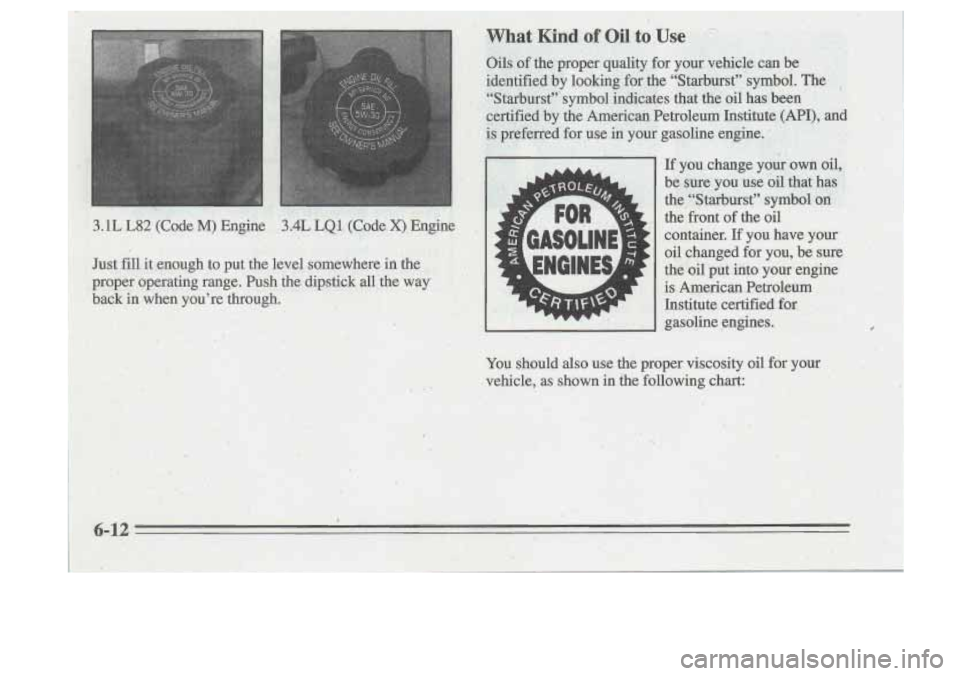
..
,.
3.1L L82 (Code M) Engine 3.4L LQl (Code X) Engine ,
Just fill it enough to put the level somewhere in the
proper operating range. Push the dipstick all the way
back in when you’re through.
,What Kind of Oil to Use
Oils of the proper quality for your vehicle can be
identified by
looking for the “Starburst” ‘symbol. The ,
“Starburst”’symbo1 indicates that the oil has been
certified by the American Petroleum Institute
(API), and
is preferred for use in your gas.oline engine.
If you change your own oil,
be sure you use oil that has
the “Starburst” symbol
on
the front of the oil
container.
If you have your
oil changed for you, be sure
the oil put into your engine
is American Petroleum
Institute certified for. gasoline engines.
You should also use &@ proper viscosity oil for your
vehicle, its sh~wn in the fdowing chart: ’ 3.
Page 217 of 340
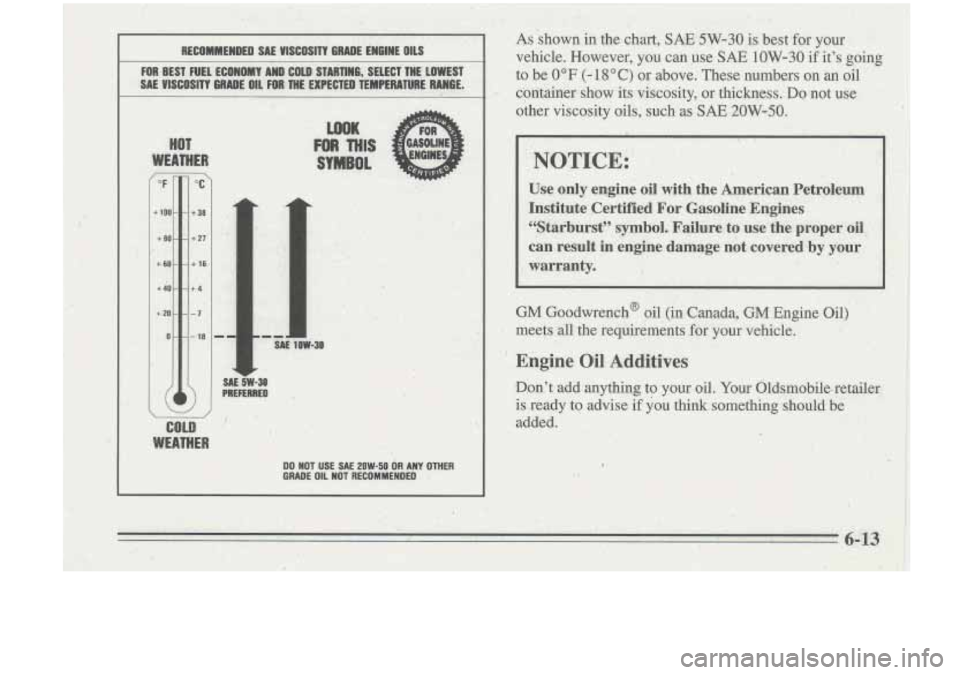
I-
I , “F
+ 100
+ 80
+ 60
+ 40
+ 20
0
- -
I- -
I- -
I- -
I- -
I- -
-_
COLD
WEAT~EA
n “C
- +3a
- +27
- + 16,
- f~4
- -7
- -18
I
. MOT
WEATHER
PO. NOT USE S4E OOW-50 6R.ANV OTHER GRAUE OIL NOT RECOMMENDED .,
..
I
Page 220 of 340
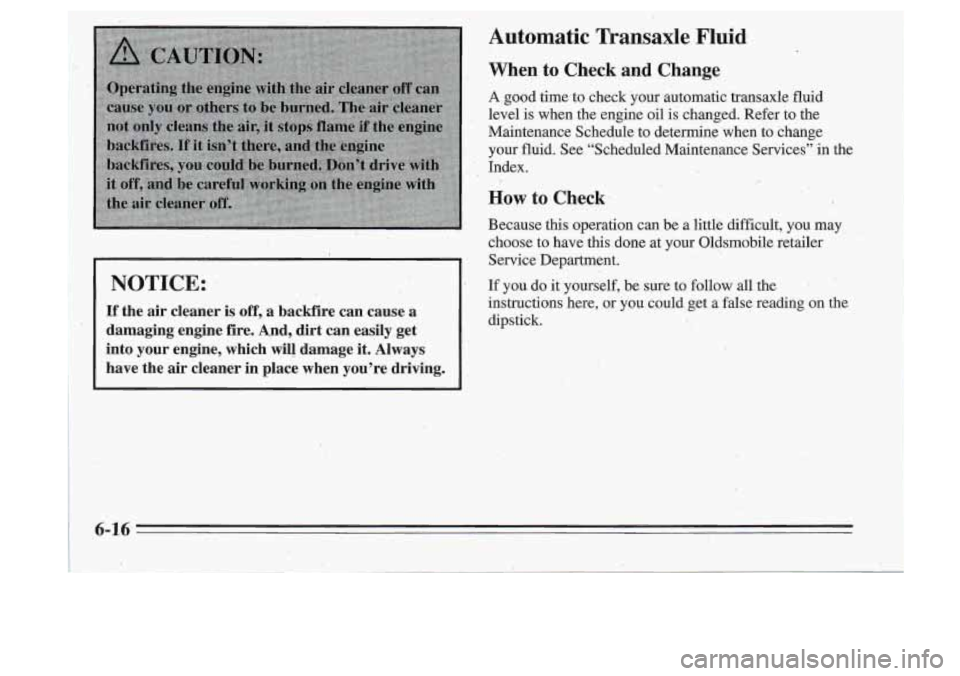
NOTICE:
If the air cleaner is off, a backfire can cause a
damaging engine fire. And, dirt can easily ,get
into your engine, which will damage it. Always
have the air cleaner in place when you’re driving.
Automatic Transaxle Fluid
When to Check and Change
A good time to check your automatic transaxle fluid
level is when the engine oil is changed. Refer to the
Maintenance Schedule to determine when to change
your fluid. See “Scheduled Maintenance Services’’ in the
Index.
How to Check
Because this operation can be a little difficult, you may
choose to have this done at your Oldsmobile retailer
Service Department.
If yon do it yourself, be sure to follow all the
instructions here,
or you could get a false reading on the
dipstick.
Page 247 of 340
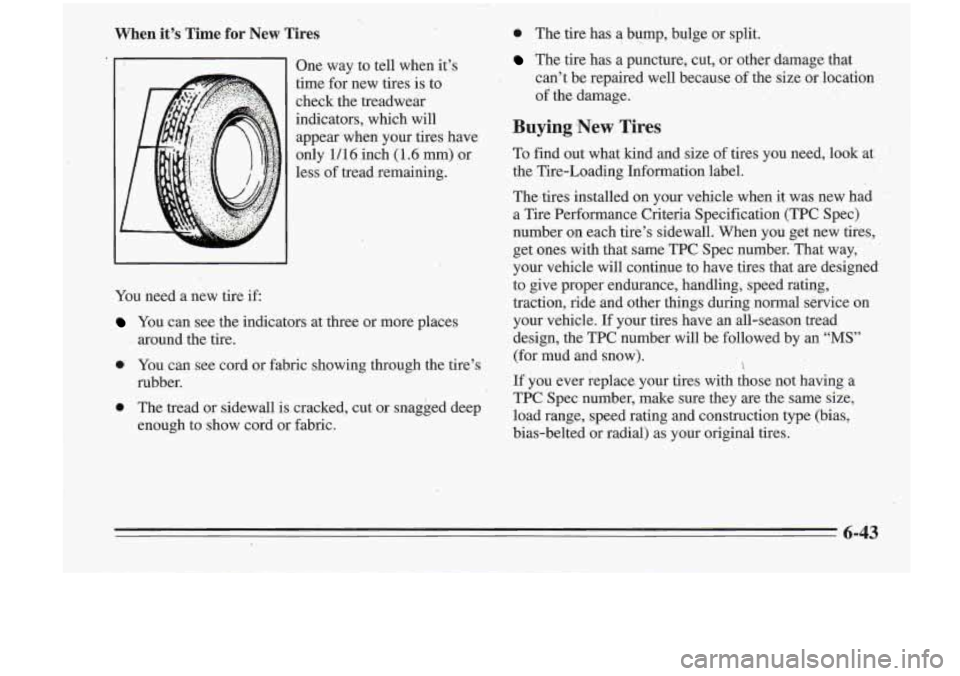
‘\..
When it’s Time for New Tires
One way to tell when it’s
time for new tires
is to
check the treadwear
indicators, which will appear’ when your tires have
only
1/16 inch (1.6 mm) or
less of tread remaining.
You need a new
tire if:
You can see the indicators at three or more places
around the tire.
a’ You can see cord or fabric showing through the tire’s ’
rubber. I
0 The tread or sidewall is cracked, cut or snagged deep
enough to show cord or fabric.
0 The tire has a 1 bump, -., bulge or split.
The tire has a puncture, cut, or other damage that
can’t be repaired well because of the
size or location
of the damage.
Buying \New Tires
To find out what kind and size of tires you need, look at
the Tire-Loading Information label.
Theltires installed
on your vehicle .when it was new had
a Tire Performance Criteria Specification (TPC Spec)
number on each tirk’s sidewall. When you get new tires,
get ones with that same TPC Spec number. That way,
your vehicle will coniinue to have tires that are designed- to give proper endurance, handling, speed rating,
traction, ride and other things during normal service on
your vehicle. If your tires have an all-season tread
design, the TPC number will be foilowed by an
“MS”
(for mud and snow).
If you ever replace, your tires with those not having a
TPC Spec number, make sure they are the same size,
load range, speed rating and construction type (bias,
bias-belted or radial) as your original tires.
Page 253 of 340
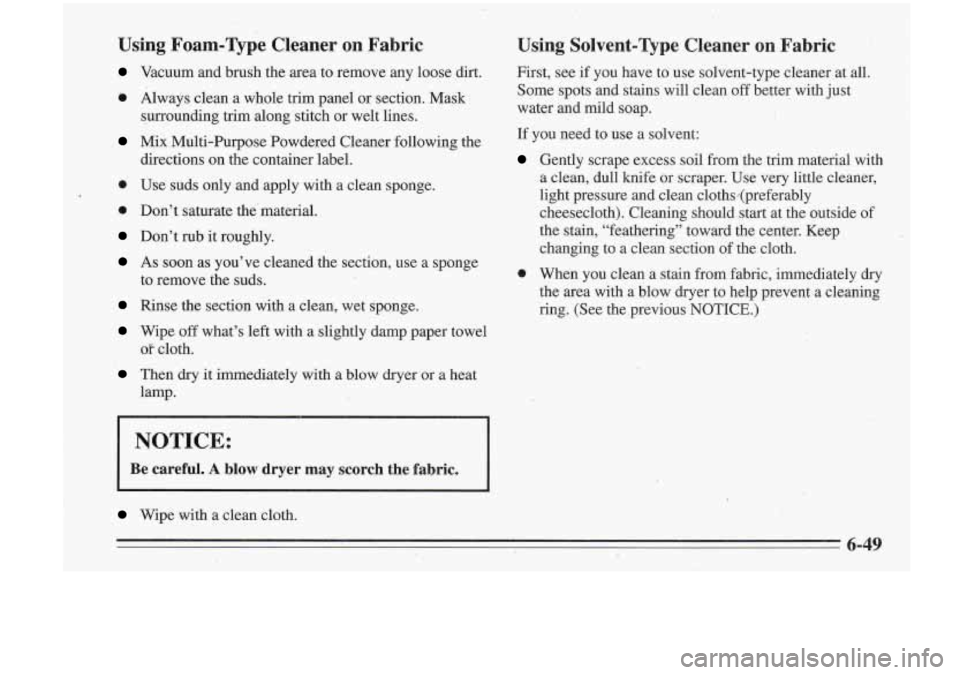
Using Foam-Type. Cleaner on Fabric
Vacuum and brush the area to remove any loose dirt.
Always clean a whole trim panel or section. Mask
surrounding trim along stitch or welt lines.
directions on the container label.
Mix Multi-Purpose Powdered Cleaner following the
@ Use suds only and apply with a clean sponge.
@ Don’t saturate the’material.
Don’t rub it roughly.
As soon as you’ve cleaned the section, use a sponge
to remove the suds.
Rinse the section with a clean, wet sponge.
Wipe off what’s left with a slightly damp paper towel
of cloth.
Then dry it immediately with a blow dryer or a heat
lamp.
NOTICE:
Be careful. A blow dryer may scorch the fabric.
Wipe with a clean cloth.
Using Solvent-Type Cleaner on Fabric
First, see if you have to use solvent-type cleaner at all.
Some spots and stains will clean off better with just
water and mild soap.
If you need to use a solvent:
Gently scxape excess soil from the trim material with
a clean, dull knife or scraper. Use very little cleaner,
light pressure and clean cloths/(preferably
cheesecloth). Cleaning should start at the outside of
the stain, “feathering” toward the center. Keep
changing to a clean section of the cloth.
e When you clean a stain from fabric, immediately dry
the area with a blow dryer to help prevent a cleaning
ring. (See the;previous
NOTICE.)
6-49
Page 257 of 340
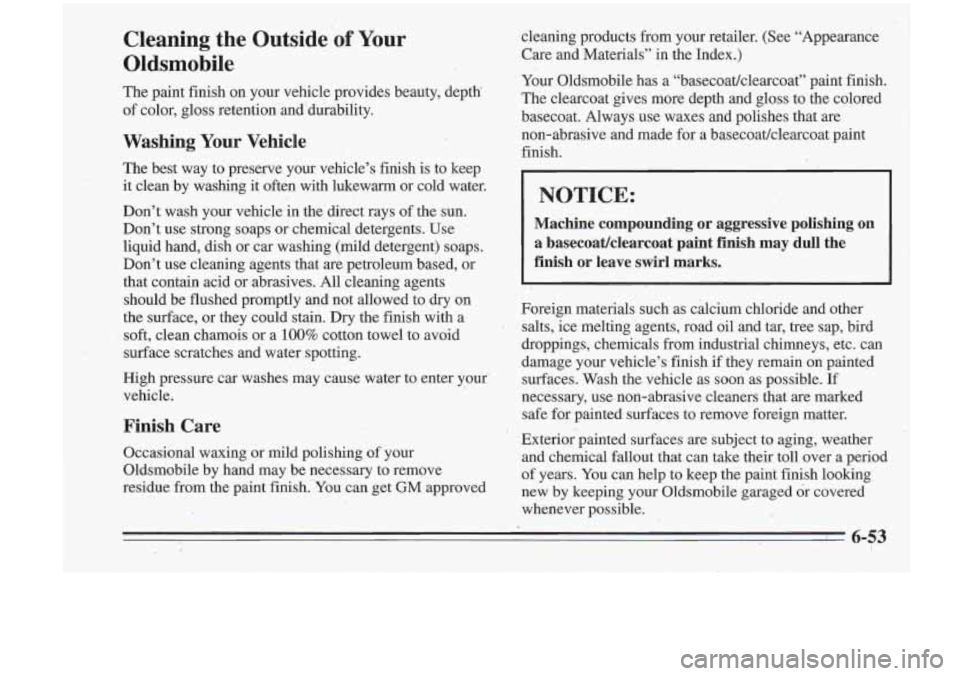
Cleaning the Outside of Your
Oldsmobile
The paint finish on your vehicle provides beauty, depth’
of color, gloss retention and’durability.
Washing Your Vehicle
The best way to preserve your vehicle’s finish is to keep
it clean by washing it often with lukewarm or cold water.
Don’t wash your vehicle in the direct rays of the sun.
Don’t use strong soaps or chemical detergents. Use
liquid hand, dish or car washing (mild detergent) soaps.
Don’t use cleaning agents that are petroleum based, or
that contain acid or abrasives. All cleaning agents
should be flushed promptly and not allowed to dry on
the surface, or they could stain. Dry the finish with a
soft, clean chamois or a
100% cotton towel to avoid
surface scratches and water spotting.
High pressure car washes may cause water to enter your’
vehicle.
Finish Care
Occasional waxing or mild polishing of your
Oldsmobile by hand may be necessary to remove
residue from the paint finish.-You can get GM approved cleaning products
from your retailer. (See “Appearance
Care and Materials” in the Index.)
.Your Oldsmobile has a “basecoatklearcoat” paint finish.
The clearcoat gives more depth and gloss to the colored
basecoat. Always use waxes and polishes that are non-abrasive and made for a basecoatklearcoat paint
finish.
NOTICE:
Machine compounding or aggressive polishing on
a basecoatklearcoat paint finish may dull the
finish or leave swirl marks.
- _=I__ x.-.: ~ ’-, - ,. -r _..-. . .
Foreign materials such as calcium chloride and other
salts, ice melting agents, road oil and tar, tree sap, bird
droppings, chemicals from industrial chimneys, etc. can
damage your vehicle’s finish
if they remain on painted
surfaces. Wash the vehicle as soon as possible.
If
necessary, use- non-abrasive cleaners that are marked
safe for painted surfaces to remove foreign matter.
Exteriorpainted surfaces are subject to aging, weather
’
and chemical fallout that can take their toll’over a period
of years. You can help to keep the paisit finish looking
new by keeping your Oldsmobile garaged or covered
whenever possible.
Page 271 of 340
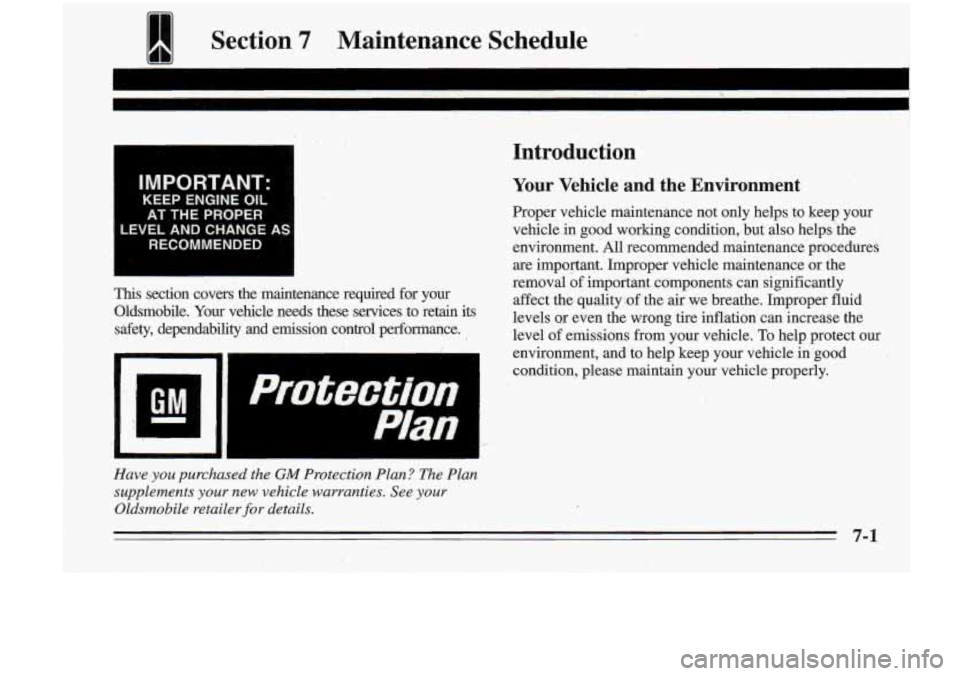
1 Section 7 Maintenance Schedule
I
IMPORTANT:
KEEP ENGINE OIL
AT THE PROPER
LEVEL AND CHANGE AS
RECOMMENDED
This section covers the $ naintenml ce required for yoiir
Oldsmobile. Your vehicle,needs these services to retain its
safety, dependability .and emission control performar ,
Introduction
Your Vehicle and the Environment
Proper vehicle maintenance not only helps to keep your
vehicle in good working condition, but also helps the
environment. All recommended maintenance procedures
are important. Improper vehicle maintenance or the
removal of important components can significantly
affect the quality 'of the air we breathe. Improper fluid
levels or even the wrong tire inflation can increase the
level of emissions from your vehicle.
TO help protect our
environment, and to help keep your vehicle ingood
condition, please maintain your vehicle properly.
Have you purchased the GM Protection -Plan? The Plan
supplements
your new vehicle warranties. See your
Oldsmobile retailer for details.
7-1
Page 274 of 340

,i
Maintenance Schedule
Schedule I Definition
Follow Maintenance Schedule I if any one of these is
true for your vehicle:
' Most tripsare less than 5 to 10 miles (8 to 16 km).
This 'is particularly important when outside
temperatures are below freezing.
0 'Most trips include extensive idling (such as frequent
driving in stop-and-go traffic).
Most trips are through dusty areas.
You frequently tow a trailer or use a carrier on top of
Schedule
I should also be followed if the vehicle is used
for delivery service, police, taxi, or other commercial
application. your vehicle.
I Schedule I Intervals
Every 3,000 Miles (5 000 b) or 3 Months,
'Whichever Occurs First
Every
6,000 Miles (10 000 km) or 6 months,
Whichever Occurs First
Chassis Lubrication
At-6,000 Miles (10 000 km) - Then Every
12,000 Miles (25 000 km)
Every 15,000 Miles (25 000 km).
Every 30,000 Miles (50 000 km),
Engine Oil and Filter Change
I
Tire Rotation
Air Cleaner Filter Inspection, if driving in dusty conditic
Air Cleaner Filter Replacement Spark Plug Replacement
Spark Plug Wire Inspection
Fuel Tank, Cap and Lines Inspection
Engine Accessory Drive Belt Inspection (or every 24 months, whichever occurs
first)
ms
Cooling System Service (or every
24 months, whichever
occurs first)
Every 50,000 Miles (83 000 km)
At 60,000 Miles (100 000 km) - Then Every.
15,600 Miles (25 000 km)
Autdmatic Transaxle Service (severe conditions only)
Camshaft Timing Belt Inspection (3.4L Code
X engine only)
7-4
!
Page 275 of 340
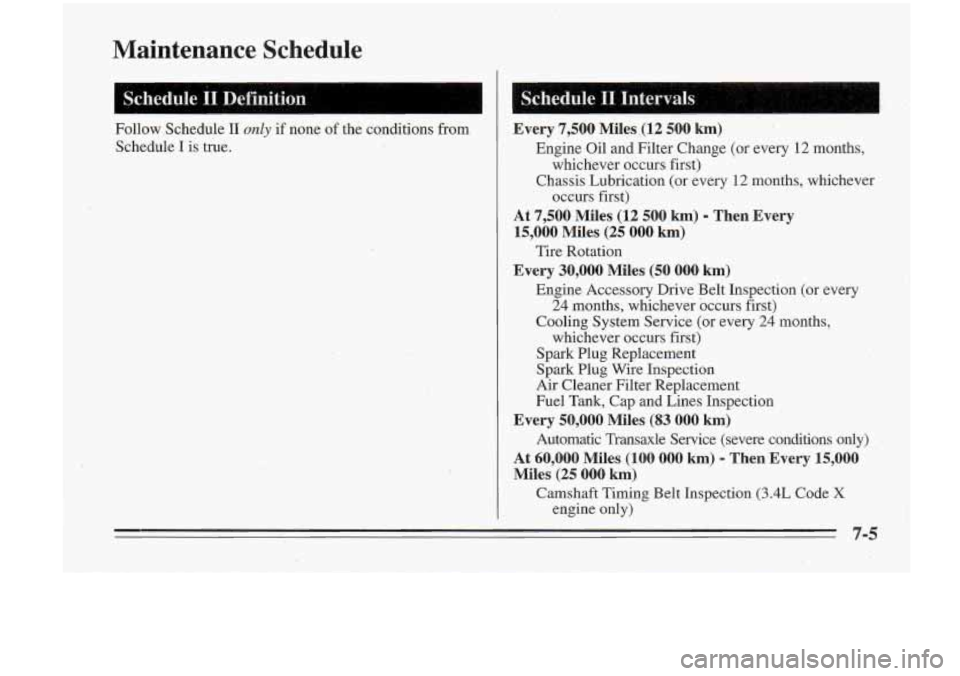
Maintenance Schedule
Schedule II~Definition
Follow Schedule II only if none of the conditions from
Schedule
I is true.
I
1:; S.chedule 11. Intervals (1, a 1 k I ,
Every 7,500 Miles,(l2 500 km)
Engine Oil and Filter Change (or every 12 months,
Chassis Lubrication (or every
12 months, whichever
whichever occurs
first)
occurs first)
At 7,500 Miles (12 500 km) - Then Every
15,000 Miles (25 000 km)
Every 30,000 Miles (50 000 km)
Tire Rotation
Engine Accessory Drive Belt Inspection (or every
24 months, whichever bccurs first)
Cooling System Service (or every
24 months,
whichever occurs first)
Spark Plug Replacement
Spark Plug Wire Inspection
Air Cleaner Filter Replacement
Fuel Tank, Cap and Lines Inspection
Automatic Transaxle Service (severe conditions only)
Every 50,000 Miles (83 000 km)
At 60,000 Miles (100 000 km) - Then Every 15,000
Miles (25 000 km)
Camshaft Timing Bel& Inspection (3.4L Code X
engine only)
7-5